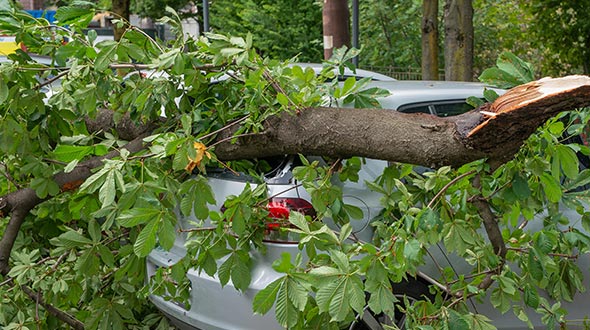
Avoid catastrophic property damage or serious injury when your tree sporadically drops a branch. By knowing why and how this happens, you can take the preemptive steps to stop it from disrupting your life and property.
toddsmariettatreeservices.com defines what self-pruning is, how it happens, why it happens, and which tree species are more likely to do it.
What is Self-Pruning
Self-pruning or cladoptosis is a compartmentalization process involving the shedding of shaded, diseased, or infested branches that have become a drain or a burden on a tree’s resources.
Further defined, this is nature’s way of letting a tree determine which branches need to go, rather than an arborist or a property owner making the decision for it.
Note: On wooded land, self-pruning is a common occurrence, especially in densely populated stands where there is not sufficient sunlight for trees to keep all of their branches. Branches low on tree trunks will likely die from shading and competition, occurring over several growing seasons.
How Self-Pruning Happens
Self-pruning occurs the same way fall foliage, shoots, and twigs are shed from a deciduous tree. As it does with leaves, ripe fruit, flowers, and seeds, a tree will form an abscission layer where the branch connects to the trunk (at the branch collar) and shed the branch cleanly.
Why Self-Pruning Happens
Several reasons can cause a tree to self-prune. Consider the following possibilities:
- A branch is too shaded and cannot sufficiently photosynthesize
- Poor pruning has left the canopy too dense, obstructing light from its reaching inner branches
- Disease has infected the branch causing its decline or hydraulic failure
- The branch has become infested, triggering self-pruning as the tree’s defensive measure
- Climbing vines have blocked sufficient sunlight in the canopy to trigger cladoptosis

Self-pruning is more prevalent in dense forests, orchards, more mature trees, and landscape areas that have been over-planted.
Basically, when a tree branch cannot sufficiently photosynthesize (due to a lack of sunlight) or has triggered an infection or infestation response, the tree can spring into action and self-prune the branch.
Regarding shaded branches, how long one survives will vary among tree species and its degree of shade tolerance. Shade tolerance relates to the capacity of a tree species to compete and thrive under shaded conditions. Shade-tolerant species like American beech and eastern hemlock are More proficient at balancing photosynthesis and respiration when growing with severely limited light.

Sometimes, the death of a branch does not necessarily ensure its shedding. Although the tree shuts the branch off from water and nutrients, depending on the species, it won’t sever it. In these cases, the tree enlists outside help. These dead branches persist until further weakened by fungi, insects, animals, wind, snow, ice, or gradual decay. At some point, the branch will weaken and fall from its own weight.
Note: In well-kept yards and landscapes, dead, dying, and diseased branches are usually pruned away before cladoptosis can take place.
Trees That Self-Prune
Self-pruning is more prevalent in the fall, and as your trees age, they are more likely to shed more limbs. The following species are known to self-prune, and can do it without warning:
- Ashes
- Aspen
- Birch
- Cherries
- Cypress
- Elms
- Eucalyptus
- Larches
- Maples
- Oaks
- Pecans
- Pines
- Poplars
- Walnut
- Willow

While it is good practice to remove limbs that grow over your home or other structures, it is necessary to remove them if you have a tree species known to self-prune.
How To Prevent Trees from Self-Pruning
Even with the best care and attention to the needs of your tree, you may not be entirely successful at preventing it from self-pruning. However, the following will help you slow this natural process:
Tree Health – From the time your tree is planted, you should provide it with:
- Water (two to three waterings per week and more often during drought conditions)
- Soil (test frequently to adjust nutrient levels and soil pH)
- Mulch (to protect the root plate and regulate soil temperature); click here to learn more about mulching
- Prune (to encourage healthy growth and remove unwanted/unneeded growth)
- Inspect (annual inspections by a professional tree service can help detect issues before they develop)
Tip: When selecting a tree species for your yard or landscape, choose a species that is appropriate for your region’s climate and not prone to self-pruning.
Cladoptosis
In this article, you discovered the definition of self-pruning trees, how the process happens, what causes it, and the species most likely to do it.
By taking steps to increase the health of your tree and the sunlight it receives, you can avoid being taken by surprise when your tree suddenly drops a branch.
Allowing your tree to grow without proper care and attention can lead to it self-pruning unannounced, suddenly dropping branches, causing catastrophic damages to anything or anyone below.
Sources:
northernwoodlands.org/articles/article/woods-whys-self-pruning-branches
cals.arizona.edu/yavapai/anr/hort/byg/archive/pruningshadetrees.html
plantclinic.tamu.edu/2013/11/15/cladoptosis-an-interesting-phenomenon/
warnell.uga.edu/sites/default/files/publications/Tree%20Anatomy%20Defining%20Twigs_14-21.pdf
(678) 505-0266
Originally published on: http://www.toddsmariettatreeservices.com/self-pruning-trees-cladoptosis/

No comments:
Post a Comment